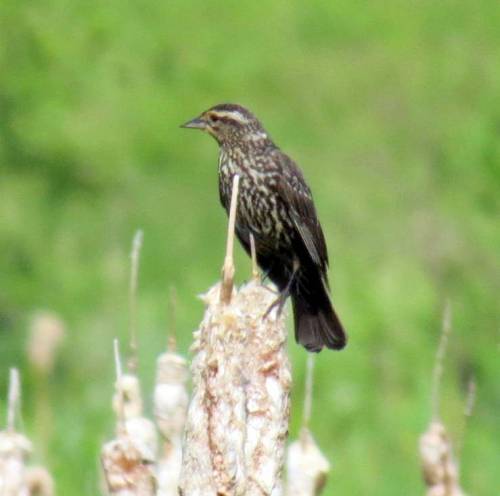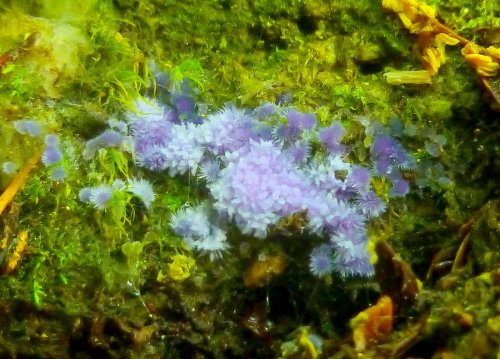I saw a fly on a milkweed leaf and he was open to posing, so here he is. I think he’s a tachinid fly because of his bristly abdomen. Some of these flies can be very helpful in the garden, controlling squash bugs and stinkbugs. Others aren’t so helpful, and parasitize moths and butterflies, including monarchs. This one was a little lumpy up around the shoulders and looked like it had been parasitized too.
As I seem to do every year I stumbled into a red winged blackbird nesting site recently. The female shown here flew off half way across a pond to sit on a cattail and wait for me to leave while the male hovered above my head screeching at me. The same thing happened last year so I’ve learned that male red winged blackbirds can get angry very quickly, and they don’t easily back down when you’re near a nest. I got out of there as quickly as I could after taking a couple of quick photos.
I’m seeing more butterflies now but the only ones willing to pose are the white admirals. Even this one wasn’t that willing. It sat still for only a couple of quick shots and then flew off.
It landed on another leaf and then turned so he could see me before settling down to give me a hard stare.
I’m not very clever when it comes to insect identification but I think I should at least try before I bother the folks at bug guide, so I searched website after website and leafed through my insect guide before giving up on this one. It turns out the reason I couldn’t identify it is because I was looking for a moth and this is a butterfly. The good folks at bug guide.net tell me it’s a European skipper (Thymelicus lineola.) I didn’t even know that we had European butterflies here and its furry body had me convinced that it was a moth. It seemed very interested in flowering grasses.
The folks at bug guide tell me that this is a Tetragnatha spider, which is also known as a long jawed orb weaver. There are hundreds of species in the genus and I must have looked at more than half of them before giving up on ever being able to identify it. They are also called stretch spiders because of their long bodies. When threatened they stretch their legs out front and back and pull them close to their body so they look long and thin like a blade of grass.
We’ve had very dry weather here this spring and are still considered in a drought but every now and then the humidity will creep up and we’ll get a thundershower, and that is perfect weather for slime molds. These pictured are the fruiting bodies of a slime mold called coral slime (Ceratiomyxa fruticulosa, var. porioides.) They are very geometric and so small I can’t think of anything to compare them to. This slime mold likes to grow on old, bark free, well-rotted logs.
Ceratiomyxa fruticulosa slime mold has two varieties; the porioides we saw previously and this one called fruticulosa. The difference between the geometric shapes of porioides and the sausage like shapes of fruticulosa is remarkable.
The reason slime molds interest me is because they are very beautiful and also fascinating. Nobody really seems to know exactly how they move, but they do. When the microorganisms that they feed on become scarce, many of these single celled organisms meld together and move toward food as a single entity. Slime molds can reach speeds of up to 1.35 mm per second, which is the fastest rate recorded for any micro-organism.
I once followed a link that someone had used to link to this blog and found a discussion about a photo of a blue slime mold that I had posted. One person said that there was no such thing as blue slime molds so the photo must have been Photo Shopped, but since I don’t try to deceive people on this blog it wasn’t. There are indeed blue slime molds, but they’re rare enough so I might see one each year if I’m lucky. I found another one just the other day, and this photo of it hasn’t been Photo Shopped or enhanced in any way. Last year I saw one very similar in shape to this one and it was gray.
Mushrooms have been very scarce because of the dry weather but my daughter sent me this photo of a hemlock tree loaded with hemlock varnish shelf fungi (Ganoderma tsugae) that she saw recently. I’ve never seen so many on one tree. You can tell that they’re young because of the white stripe on their outer edges. As they age they will lose the stripe and become deep red. This mushroom has been used medicinally in China for thousands of years.
Several years ago I found purple cones on a pine in a local park. I’ve checked every year since and never saw them again until just recently. I’m not sure what kind of pine this is but I don’t think that it’s a native tree. I love the color of its cones, native or not.
Timothy grass has just started to flower. Each flower head is filled with tiny florets, each with three purple stamens and 2 wispy white stigmas. Timothy makes an excellent hay crop and gets its common name from Timothy Hanson, a farmer who began to cultivate and promote it in 1720, a few years after its introduction into colonial America in 1711. It should be cut for hay before it reaches this stage but it’s quite beautiful when it blossoms.
I am grateful for the magic, mystery and majesty of nature – my loyal friend and companion – always there, welcoming and waiting for me to come; to be healed. ~Tom North
Thanks for coming by.











